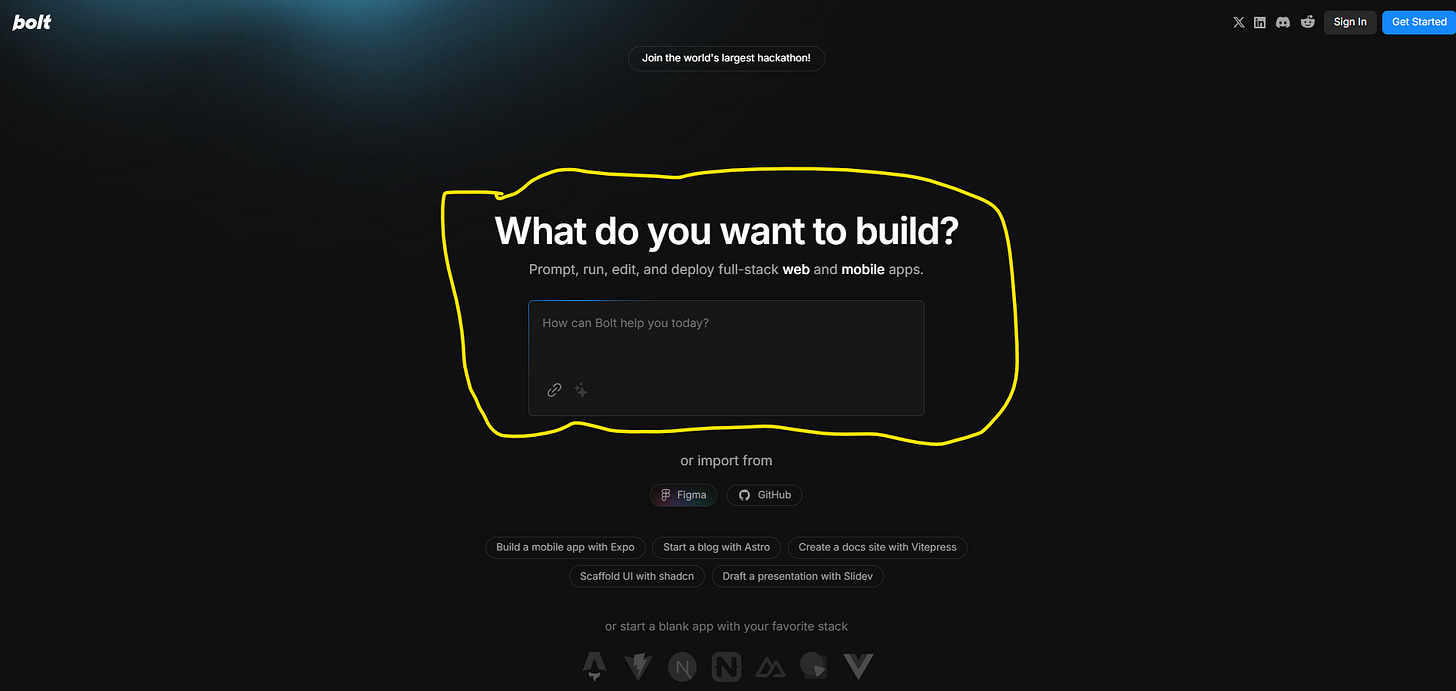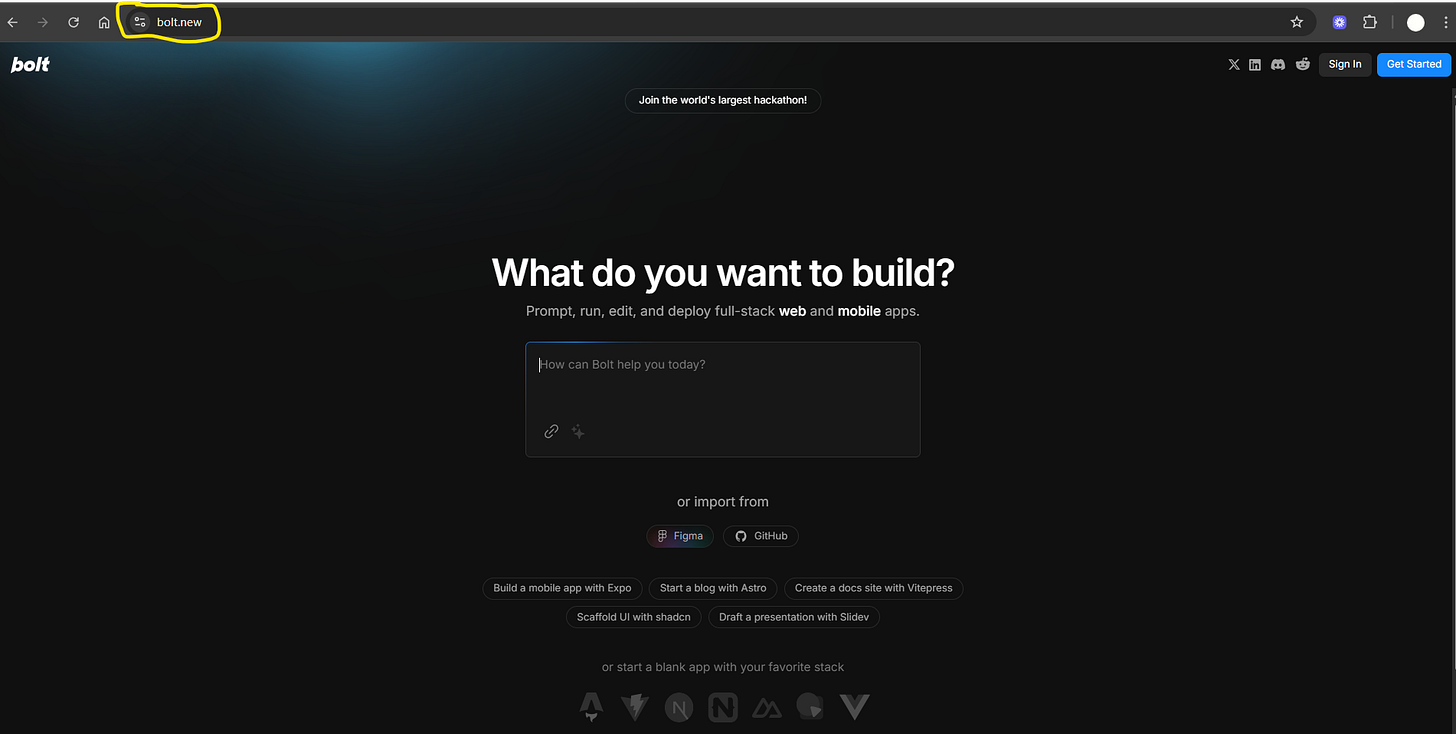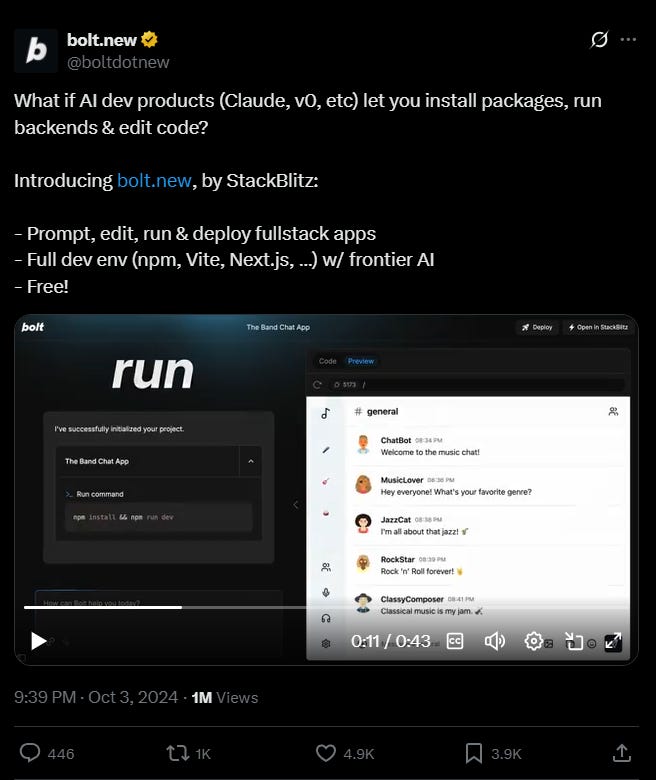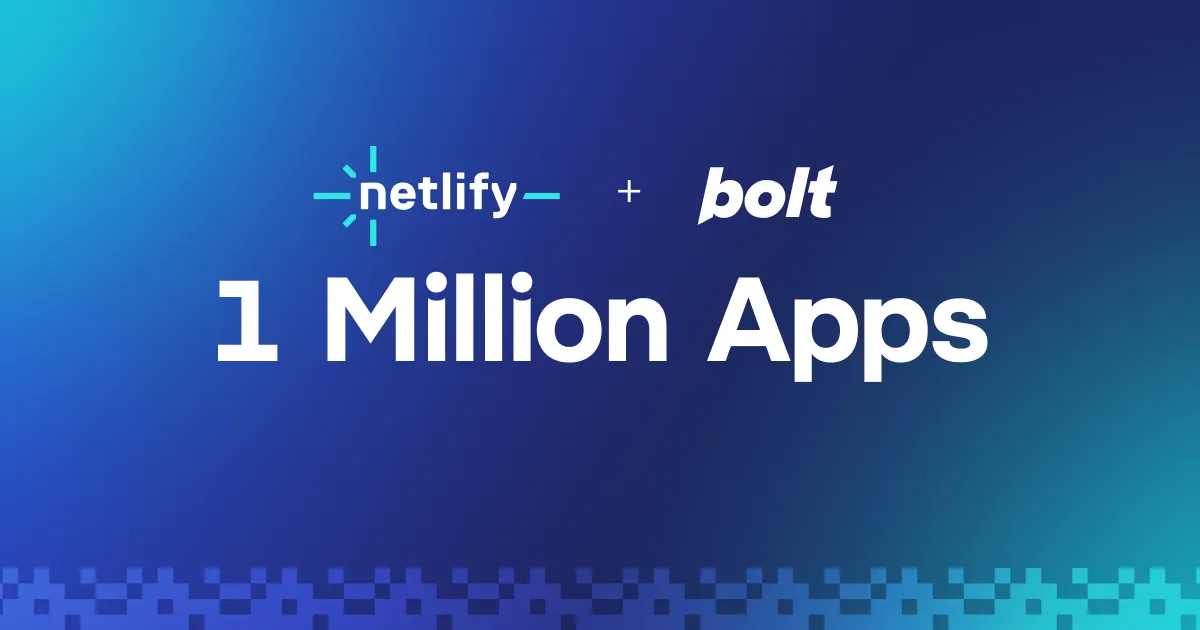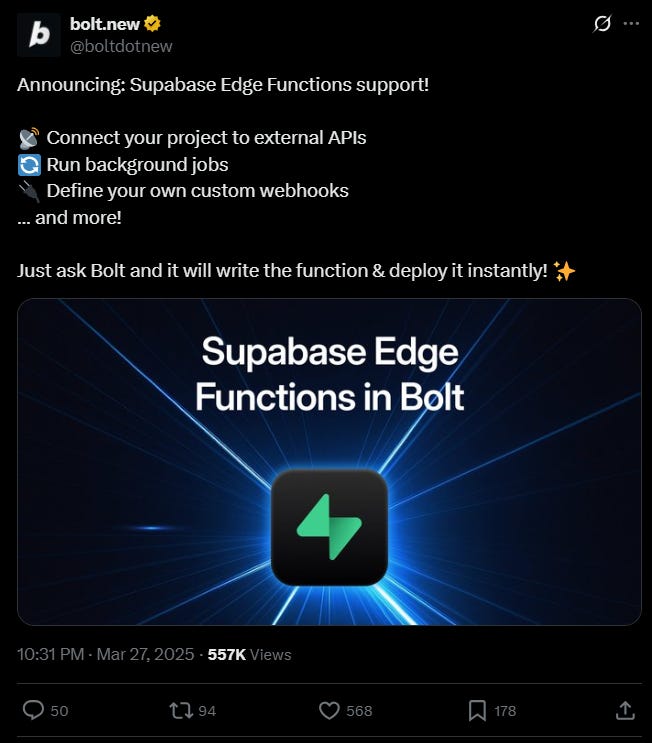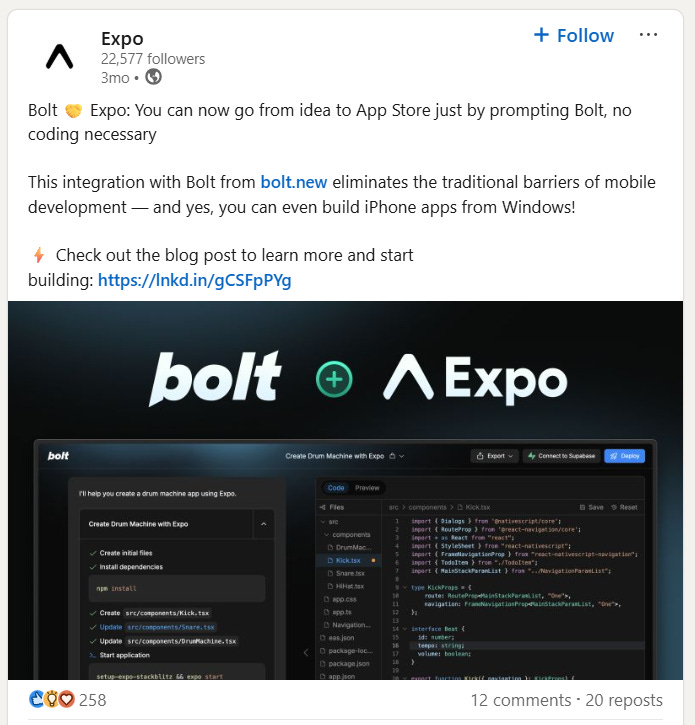From Near-Shutdown to $40 M ARR: How Bolt.new Hacked Its Growth
Steal Bolt.new’s Growth Playbook.
In short:
How did Bolt.new hack its growth?
By building an insanely great, frictionless product at just the right time – and then doubling down on every mechanism that could amplify its reach and value.
What can you learn?
Aim to deliver step-change value, remove friction everywhere, use existing platforms and communities, and let success snowball through strategic loops.
Growth, when done like this, is rapid and resilient.
How it all started.
StackBlitz launched in 2017 as an online IDE. Its WebContainer tech let Node.js run fully in the browser, drawing a loyal band of developers. By 2022 the IDE served about two million users, and big firms such as Google and Uber used it for sandbox demos and bug hunts. Revenue lagged.
The team had no repeatable way to make money. By late 2023 annual sales sat near $80 k and growth was flat. At a December board meeting investors gave an ultimatum: prove real traction in 2024 or close the doors. Co-founders Eric Simons and Albert Pai even weighed selling the company.
A break came in June 2024. Anthropic released Claude 3.5 Sonnet, a language model that wrote solid code. Simons saw its fit with WebContainers at once. Earlier AI helpers failed on full apps; Claude did not.
The team shelved the old IDE plan and built a text-to-app tool on WebContainers. They named it Bolt.new. The rebuild took roughly ninety days—a last-chance sprint backed by seven years of work.
StackBlitz partnered with Anthropic instead of competing. Claude’s API sat at the core of Bolt, turning plain English into code and fixing errors in chat. Anthropic had floated a $300 k unlimited WebContainer licence that spring, but the deal expired unsigned. StackBlitz kept full control and pressed ahead.
Bolt.new went live on 3 October 2024 with a single tweet and no ads. Early users shared what they built. Anyone could open a browser, describe an idea, and see a web or mobile app spin up in minutes.
Claude wrote the code; WebContainers ran it on the spot. Results were instant.
In its first week Bolt reached about $1 million in annual run-rate revenue. Simons told investors, “$0 to $4 M ARR in 30 days.” The pivot worked. Years of groundwork met the right moment, and StackBlitz leapt from near shutdown to breakout growth.
Crafting a Friction-Free 10× Product
Bolt.new’s product design removed nearly all friction from software creation. The goal was a “10× easier” experience than traditional development. And they did it:
Zero Setup, Zero Wait: Users can literally just visit
bolt.newin their browser and start building. There’s no IDE to install, no environment to configure – not even a signup required to get started.For example, a user can go to the site and type “Make a clone of Spotify”. In under 60 seconds, Bolt generates a working web app with that description.
This immediate gratification is something coding has never offered before. By eliminating setup time (usually hours or days to scaffold a project), Bolt ensures new users hit an “aha!” moment almost instantly.
AI-Driven Build-Deploy Loop: Bolt’s not-so-secret sauce is the closed-loop integration of coding + running + deployment. Users converse with the AI to add features or fix bugs, and the code updates in real time in the browser.
When ready, deployment is one click. Bolt integrated directly with hosting and database platforms so that every app can be live on the internet with virtually no effort.
This means the traditional multi-step process (write code → test locally → push to repo → configure hosting) is collapsed into a single, AI-assisted flow.
It’s software development on easy mode.
One user, for instance, described how “you can give prompts as text or images and [Bolt] generates a whole codebase with files and directories” – all fully runnable.
.newDomain = Mindshare: Using a .new domain turned out to be a clever growth catalyst. The.newTLD, introduced by Google, is associated with quick actions (e.g. docs.new opens a new Google Doc).Bolt.new used this familiarity. Sharing the product was as simple as telling someone “go to bolt.new and try it.” The domain itself implies “create something new now.”
This is my personal opinion that this boosted click-through and memorability (a small hack that lowered the psychological barrier to try it).
In growth terms, a memorable one-word domain that doubles as a call-to-action is marketing gold. Users tried it on a whim and were immediately hooked by the instant results.
Generous Free Tier: Bolt’s business model uses a freemium, usage-based strategy. Every new user gets a free tier (about 1 million tokens of AI processing), which is enough to build small projects at no cost.
This free tier was critical in driving adoption – anyone curious could play with Bolt and build something tangible without pulling out a credit card. Because StackBlitz’s WebContainer tech offloads compute to the user’s device, it costs the company far less to support free usage.
In essence, Bolt’s engineering efficiencies subsidized its growth.
The result: tens of thousands of users signed up rapidly, knowing they could experiment for free. And once they experienced the 10× faster build cycle, many upgraded to paid plans for bigger projects.
The free-to-paid conversion was powered by genuine value, not aggressive paywalls.
Bolt.new stripped out the pain. No frameworks to learn, no AWS to wire, no team to hire.
You type the idea and watch the app appear.
Non-coders ship projects.
Developers spin quick prototypes.
Ten-times faster at one-percent of the cost. A product that sharp sells itself; users do the selling.
Growth Engine: Acquisition → Activation → Retention → Referral → Monetization
Bolt.new didn’t rely on just one trick to grow – it built a full funnel engine from acquiring users all the way to monetizing them.
Let’s break down how Bolt guided users through each stage of the A→A→R→R→R growth funnel, shall we?
Acquisition:
Bolt.new’s initial user acquisition was largely organic and viral. The launch via a single tweet caught fire among tech circles.
Enthusiastic early adopters started sharing what Bolt could do – on Twitter/X, Hacker News, Reddit, and LinkedIn. Within days, word-of-mouth brought tens of thousands of new users to try it.
The combination of a free tier and a jaw-dropping value prop (build an app by chatting!) made for inherently shareable content.
Bolt also benefited from founder-driven marketing: CEO Eric Simons and investors like Jake Saper posted eye-popping metrics (e.g. “$20M ARR in 2 months!”) on LinkedIn, generating buzz.
This social proof from credible sources drove even more curiosity traffic.
So, a great product plus public wins = magnet for new users. Bolt spent almost nothing on ads; its users and backers did the promotion by celebrating its success.
Here’s the launch video:
Activation:
Getting users in the door is only half the work – Bolt then also excelled at converting sign-ups to active users. The key was that first user experience: new users would see a prompt like “Describe the app you want to build,” enter a sentence, and within a minute have a running app.
That immediate “wow” moment was Bolt’s activation secret.
The platform’s design ensured that nearly every new user created something useful in their first session.
According to Anthropic, usage was doubling shortly after launch as users kept engaging deeply.
By making the onboarding almost instant and the output tangible (a live app you can interact with), Bolt achieved a high activation rate.
Many who just came to “toy around” ended up investing hours extending their app because the loop was so addictive.
New users experienced success right away.
Retention:
Bolt.new saw strong early retention, though not without challenges.
On the positive side, Bolt became sticky for users who had real projects or prototypes to flesh out. Once someone started an app, they often returned repeatedly to refine it with the AI, essentially learning as they built. The company’s data showed over 1 million active users regularly using the product within a few months, indicating many came back beyond day 1.
Bolt’s team reinforced retention by rapidly improving the service. They held daily all-hands calls to squash bugs and push new features quickly.
For example, they noticed users hitting limits of the AI or needing guidance, so they launched “Bolt Builders,” a network of expert freelancers available to help users live for tough problems. This gave users somewhere to turn when the AI got stuck, preventing abandonment.
But obviously, some users complained about the AI making mistakes or projects getting complex beyond Bolt’s capabilities. Bolt’s usage-based pricing also meant if the AI churned through tokens on errors, users could get frustrated paying for its mistakes.
The team addressed these pain points, and overall the value of a functioning app in hand kept many users engaged.
Referral:
Satisfied Bolt users became a referral engine on their own. The product’s outcomes were so impressive that users loved to show off what they built. This led to organic referrals in the form of social media posts, tech blog articles, and YouTube demos.
On LinkedIn, for instance, entrepreneurs shared stories like “I built our startup’s MVP in a weekend on Bolt.new,” garnering thousands of views (each such post effectively referring countless new users).
A Reddit community also sprang up (r/boltnewbuilders) where users shared tips and success stories – acting as both support and promotion. Bolt’s team smartly fueled this by engaging with the community and highlighting user-made projects.
Notably, the huge cost/time savings became referral soundbites: e.g. one founder saved $5,000 and months of time by using Bolt instead of hiring out – a story that got around in startup circles.
By delivering results that users wanted to talk about, Bolt ensured a steady stream of incoming users through referrals and virality.
Monetization:
Finally, Bolt.new smartly optimized revenue without stunting growth.
Initially, they charged a simple $9/month subscription for unlimited use – and users blew through the limits in 48 hours! Realizing this, the team quickly pivoted to a usage-based pricing model. They introduced a token-based system with tiers: e.g. $20/month for 10 million tokens (Pro), and higher tiers at $50, $100, $200 for heavier usage.
This change meant power users paid more, capturing value from those who built larger apps, while casual users could stay on lower plans or free. Within weeks of adjusting pricing, almost half of Bolt’s paying users had upgraded to the higher-tier plans.
This drove monetization through the roof.
In fact, Bolt’s revenue went from $60K ARR on launch day to millions per month after the switch.
Importantly, the free tier remained to keep the top of funnel wide. The usage-based approach aligned price with value: businesses building mission-critical apps might spend $100–200/month, while hobbyists might never pay. Bolt thus generates healthy ARR (over $40M) by skimming revenue from high-intent users at scale.
The monetization engine accelerated further when Bolt proved its ROI – e.g. a user launching a profitable app via Bolt has no problem paying $50 for it, compared to paying developers or agencies thousands.
By monetizing flexibly and at the point of value, Bolt turned its surging user base into a fast-growing revenue base.
-
Bolt.new created growth across the entire funnel.
Free, viral acquisition, lightning-fast activation, continuous retention efforts, viral referrals, and a scalable monetization model all worked in concert.
No single silver bullet made it happen – it was the compounding effect of an outstanding product and well-executed growth tactics at each stage.
Strategic Integrations as Distribution
One of Bolt.new’s smartest growth moves was using strategic integrations as a distribution channel.
Bolt grew faster by plugging into tools people already use. Bolt unlocked new user segments and piggybacked on the reach of those ecosystems
Netlify
Day one, Bolt linked to Netlify. Build an app, hit one button, it goes live. No servers to set up. For non-coders, launch is often the hardest step; Bolt erased it. Netlify counts over one million developers and web creators. When a flood of Bolt sites hit Netlify, that crowd took notice. Sacra’s report says the Netlify tie-in (and others) sped Bolt’s market reach and revenue. Users gained painless hosting; Netlify gained fresh traffic.Supabase
Next, Bolt wired in Supabase, the open-source Firebase rival that handles databases and auth. A user can type “add sign-up” and Bolt drops in Supabase code behind the scenes. Now the same person can build a full data app, not just a static page. The link pulled in indie hackers and product managers who lean on low-code back-ends. Supabase’s good name—backed by top VCs—gave Bolt extra trust. More depth in apps meant more users willing to pay, so this link boosted revenue too.Expo
Bolt also teamed with Expo for React Native. Ask Bolt for a to-do mobile app and it spits out cross-platform code. Scan a QR code and test it on your phone at once. Thousands now build iOS and Android apps each day, many with zero mobile background. The React Native crowd spread the word, and Expo gained new traffic. A clear win for both sides.Other Integrations
Bolt tied in GitHub for code import and export, Stripe for payments, plus cloud functions, email APIs, and more. One user built an AI CRM with Stripe billing in three weeks for about $300. Each new link opened fresh use cases and fresh users. Cross-promotion followed: Anthropic’s site highlighted how Claude helped Bolt hit $4 million ARR in four weeks. That put Bolt in front of Anthropic’s entire enterprise readers.
Why It Worked
Netlify, Supabase, Expo, GitHub, Stripe: these platforms already held huge audiences. Bolt met users where they work. In return, Bolt became the simplest way to stitch those services together. Tens of thousands joined through these doors. The lesson is plain: integrate early, ride partner reach, and let shared value do the selling.
Content & Community Flywheel
Bolt.new did not grow on product strength alone. Users turned into a marketing engine that fed itself. It was a nuclear chain reaction.
Viral social content
Tech influencers shared Bolt wins.
Lenny Rachitsky called Bolt “the second fastest-growing product in history—only behind ChatGPT” and cited $20 M ARR in 60 days. His LinkedIn post reached a broad startup crowd.
An investor’s post naming Bolt the fastest ever to $20 M ARR drew hundreds of likes and dozens of comments.
On Twitter/X, developers posted code clips and GIFs of Bolt building apps in real time. Each share sparked fresh sign-ups.
The Bolt team replied, gave quick demos, and thanked posters, which pushed the conversation further.
Business Insider, Substack writers, and YouTube hosts picked up the story, adding new ARR milestones for people to quote.
YouTube and educational content
Demand for how-to guides surged.
Tech bloggers dropped walk-through videos like “Building an app in Bolt.new – full walkthrough,” pulling in thousands of views.
CEO Eric Simons joined podcasts and tutorials, showing best practices.
One talk, “Zero to ~$40 M ARR: How Bolt’s pivot changed AI product development,” mixed the backstory with a live demo.
These videos train users, boost activation and retention, and keep driving new traffic through search. Anyone typing “how to build an app with AI” now sees community-made Bolt guides.
Reddit and community support
A subreddit, r/boltnewbuilders, gathered thousands of members. They swap tips, debug issues, and show finished apps.
Peer help cuts support costs and lifts retention; newcomers feel part of a movement.
The company joins the threads, fixes bugs raised in “mixed feelings” posts, and wins trust.
Fans run a Bolt.new Builders newsletter and podcast, sharing updates and power-user interviews.
StackBlitz set up a $100 K open-source fund to back key ecosystem tools, drawing more developers into the fold.
Result: community content → user success → more positive content → more users. The loop keeps spinning.
Network effects through sharing
Apps built on Bolt carry its brand. When a user launches a project on Product Hunt or Indie Hackers, the tool gets free airtime.
Viewers ask, “How did you build that so fast?” The answer—“On Bolt.new”—brings the next wave of users.
Why it matters
Every milestone, tweet, video, or subreddit post pulled in fresh builders. Those builders, once successful, created more content and invited friends. Bolt paid little for ads because its users were its marketers. For growth teams, the lesson is clear: give people results worth sharing and help them share fast. The flywheel will handle the rest.
Engineering Moat = Marketing Edge
Bolt’s surge rests on one hard fact: WebContainers. StackBlitz spent seven years building this browser tech. It runs a full Linux-like dev stack on the user’s CPU. Where, Other Cloud IDEs sprawl across remote VMs and pay for every minute, Bolt spins up an environment in milliseconds, works offline, and adds almost no server cost.
“The web hasn’t been capable of building web applications natively… WebContainers changed that,” said co-founder Eric Simons.
Cost fuels freemium
Because code runs on the customer’s machine, Bolt can give a free tier with 1 million tokens and still remain lean. Competitors that pipe work to cloud CPUs must throttle or charge more. Bolt can host millions of users without racking up millions in cloud bills. Insiders say it delivers dev power at a fraction of the cost of cloud IDEs and keeps high profit margins.
Speed powers UX
Local execution means zero lag, live preview, and quick reloads. Users feel the snap and stay. Earlier cloud IDEs could not match that pace; Bolt turned speed itself into a sales hook.
Hard to copy
WebContainers rely on WASM threads and other deep browser work few teams master. Rivals—Replit, Lovable (which leans on Fly.io), v0, and others—still pay for server VMs. Bolt can undercut prices or raise usage limits while those firms juggle higher costs.
Profitable at scale
At $40 million ARR Bolt was already profitable. Margins held even with millions of free accounts, so revenue rose faster than expense. The surplus funds support new hires and R&D, keeping the product ahead while others burn cash.
WebContainers give Bolt speed, low cost, and scale. Those traits let the team run a generous freemium plan and boast best-in-class performance. The tech moat is the marketing edge. When your infrastructure hands you a structural win, lean on it. Bolt did—and turned that edge into momentum.
Risks & Headwinds
1. Competition heats up.
The AI-coding arena is crowded. Bolt leads the text-to-app race, but rivals run close.
Replit: $272 million raised for its AI push.
Vercel v0: backed by more than $500 million.
GitHub (Microsoft), Google AlphaCode, Cursor, Codeium, Dev-in and fresh startups all fight to automate more of the stack.
If Microsoft bakes a ChatGPT builder into Visual Studio, or Replit’s Ghostwriter beats Bolt on ease, pressure rises. Bolt’s profits and WebContainer moat give it cash and tech to reply, yet staying in front will demand nonstop innovation.
2. Product complexity and scope creep.
Bolt lets anyone ship an app, but software grows messy fast. Early testers love quick prototypes; bigger builds expose cracks. Reddit users warn, “Great for a demo, not for a full product… They are selling a dream.”
As apps scale, AI code must stay clean, secure, and easy to fix. Bugs, security holes, or shaky mobile support can dent trust. Bolt Builders—paid experts at $50 an hour—help, yet that service must scale with demand.
3. Infrastructure and AI costs.
Every prompt taps Anthropic or another model. API calls cost real money. If Claude prices rise, rate-limits hit, or servers fail, Bolt feels it. The team could train in-house models—Cursor does—but that takes time and cash.
Free users burn compute, so Bolt must keep conversion high or margins shrink. The firm once offered Anthropic an unlimited WebContainer deal for $300 k a year; it lapsed. Now they pay per token. Growth means bigger bills and a need for volume discounts or cheaper models. Newer LLMs also eat more RAM and context, which may lift costs again.
4. User trust and learning curve.
Bolt courts the “next billion developers.” Many can’t debug a crash or audit security. One bad breach could stall adoption. The team adds warnings and guardrails, but must keep ahead of attacks and careless mistakes.
Seasoned engineers doubt AI code quality. Winning enterprise deals will take proof, time, and spotless track records.
5. Keeping the curve rising.
$0 to $40 million ARR in six months is rare. Hitting $100 million will be harder. Bolt may need team workspaces, more frameworks, maybe a self-hosted option for large firms. Each step adds risk and complexity. The hype cycle will fade; only steady product gains will keep growth compounding.
The nutshell
Three threats stand out: competition, complexity, cost. Bolt’s team knows this. They use usage-based pricing to cover AI spend and enlist expert help to boost success rates. If they keep shipping and watching costs, the rocket can fly on. If they slip, growth may slow as fast as it rose.
Growth Hacks You Can Steal
Bolt.new’s playbook offers several tactical growth ideas that growth hackers like you can apply. Here are 4 actionable “hacks” inspired by Bolt’s success:
Deliver Instant WOW (Zero-Friction Onboarding): The faster a user gets value, the more likely they’ll stick.
Bolt.new let users try the product immediately – no install, no signup – and see a result in under a minute. Think about how you can remove every barrier in your onboarding.
For example, offer a one-click demo or a sandbox mode. The first 5 minutes should showcase a “magic moment.” Bolt’s approach: visit a URL, type a prompt, get a working app in 60 seconds. The user’s reaction? “Wow, that was easy.” This kind of instant gratification turns curious visitors into active users.
Takeaway: Audit your signup or setup flow and cut it to the bare minimum. Can you let users experience the core value without even creating an account?
Aim for that frictionless first hit of value – it creates momentum that no marketing budget can buy.
Ride the Big Wave Early: StackBlitz spent years on WebContainers, but real growth came when they paired their tech with the rising wave of AI.
Once Anthropic’s new model hit, they jumped on it and built Bolt in 90 days.
The lesson: timing is crucial. Identify major technology or platform shifts (AI, blockchain, remote work, etc.) that align with your product’s strengths, and pivot or integrate quickly to use them.
By being early (but prepared) on a trend, you can catch a tsunami of demand.
Bolt essentially surfed the AI wave of 2024, and that lifted them far higher than they could have gone alone.
So ask: what’s a current trend that could 10× your value proposition? How can you combine what you already have with what’s newly possible?
When you spot that fit, move fast.
An “overnight success” often comes from finally catching the right wave at the right time.
Integrate to Piggyback Distribution: Don’t build it all in isolation – plug into platforms your target users already use.
Bolt.new did this masterfully: integrating with Netlify, Supabase, GitHub, Expo, etc., meant users didn’t have to leave Bolt to accomplish key tasks. It also meant Bolt showed up in those ecosystems (e.g. Netlify users hearing about Bolt).
This is a growth hack: by integrating or partnering with a bigger platform, you gain exposure to their user base. It’s essentially OPA (Other People’s Audiences).
For example, if you have a SaaS for designers, integrate with Figma or Notion so that your tool is an add-on in those environments.
Bolt’s Netlify and Supabase partnerships removed friction for users and acted as marketing, accelerating its growth.
So, map out which adjacent platforms or communities align with your product and find ways to integrate or collaborate. It could be through an official plugin, an API integration, or co-marketing deals.
This uses established distribution channels rather than forcing you to win users one by one.
Turn Users into a Community (and Evangelists): Bolt cultivated fans and a movement along with gaining users.
The team engaged with users on Reddit (creating a community support forum), encouraged content creation (users posting tutorials, hosting a Builders podcast), and celebrated user successes (case studies, shout-outs).
This wasn’t an accident – they leaned into user-generated content.
As a hack, think of ways to spotlight your users’ achievements using your product. Encourage them to share (maybe via contests, or simply by organically highlighting their stories).
Bolt’s explosive growth was amplified by countless posts and videos from users excitedly sharing what they built. By nurturing a real community (responding to feedback, providing spaces for discussion), Bolt created a self-sustaining loop of support and evangelism.
Other startups can do this too: start a community group or forum, be ultra-responsive to your early users, and empower them to help each other. Over time, you’ll have an army of ambassadors marketing for you.
Remember, people trust other users more than they trust companies. Bolt’s subreddit and social proof on LinkedIn gave it authenticity that no ad can buy.
Each of these hacks boils down to removing friction and aligning with user behavior. Bolt.new succeeded by making it insanely easy to start, by timing the market right, by piggybacking on existing platforms, and by turning its users into passionate advocates.
Closing Takeaways
A 10× product wins. Bolt slashed the time and cost to ship software. That raw advantage made every growth tactic hit harder.
Loops beat spikes. Viral onboarding pulled people in. Integrations, community, and usage-based pricing kept them close. Each loop fed the next. Results stacked, week after week.
Timing matters. StackBlitz struggled for years. Then AI models got good. The team moved fast, matched old tech with the new wave, and caught lift.
Product first, tactics second. Pricing tweaks, partner launches, and loud metrics worked only because the core experience felt like magic. Build that, then pour fuel.
Compounding is the goal. One big post may spike traffic. Durable loops—users who teach new users—drive steady climbs. Bolt’s numbers prove it.
Keep these five rules in mind. Ship real value, build loops around it, move with the market, and let compounding do the heavy work. That’s the Bolt playbook.



